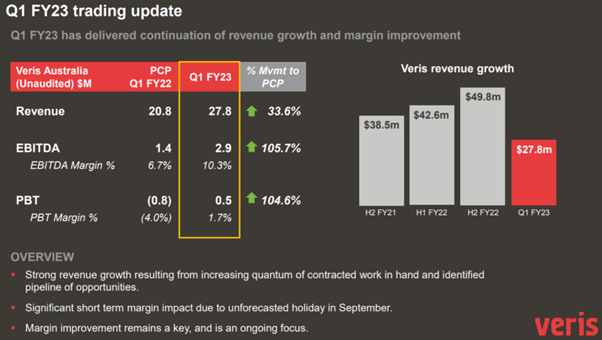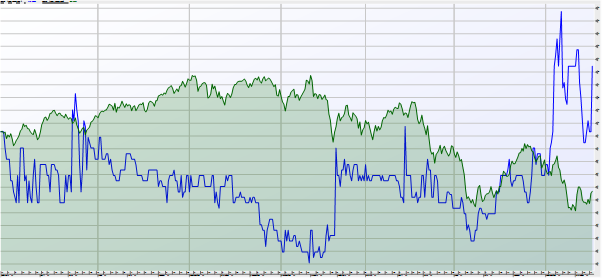A profitable microcap to play the recovery
Veris Limited (VRS.ASX VRS $0.09 Mkt Cap A$47m –
Australia’s largest national surveying company) AGM update signals a very important
milestone on the journey back to profitability. Remembering that VRS almost had
an appointment with the administrators a few years ago, has since gone through
a major restructure (after changing management), transformed the balance sheet
through non-core asset sales, has $17.2m in cash in the bank and is now
profitable (real profit after all lease expenses).
-
A Tough
Journey -
New Management (CEO Michael Shirley) was appointed in October 2019. The
business was in poor shape. Within 4 months, they had to also deal with
COVID impacts.
-
Why COVID was
so difficult to manage – VRS had acquired a national network of surveying
companies, originally headquartered in Perth, with key acquisitions in NSW
and VIC. With the largest surveying workforce, they rely on high
utilisation across sites. COVID lockdowns restricted moving both equipment
and workers to jobs in various states - a nightmare. Whilst COVID payments
helped ($4.5m in FY21 down to $1.0m in FY22) it made the restructuring
process difficult when everything you do is about improving margins.
-
Sale of Aqura – to Telstra for EV $30m
realised an investment in a non-core business they had built, allowed debt
to be paid down, strengthened their balance sheet to improve the position
with banks and negotiating leases etc. Post this they are left with A$17.2m as of June 30.
-
It's now all about
margins – VRS has come out of the ashes and has managed
to grow the revenue line of the surveying business, but more importantly,
margins are rising as management has emphasised they would. The EBITDA margin
progression signals the success of the restructure – 1.1% FY20, 9.6% FY21, 10.6% in FY22.
Surveying is not traditionally a high-margin business and sustaining 10% EBITDA
would normally be some achievement. They are capital-intensive businesses, with
fleets of cars and equipment, so lease expense is real as is depreciation.
That’s why seeing a return to an NPAT of $0.5m for Q1FY23 is a significant
milestone on the journey, and the best measure to judge the company on.
-
For a small
cap with $17m in cash in the bank – this is the key slide you want to see in the presentation.

-
A dominant player emerges in a fragmented market – The focus on margins, keeping the right people (redundancy for others), modernising fleet and equipment, focusing on systems for tendering etc, and having the largest national presence places VRS at a significant advantage in competing for tenders. Capacity utilisation and better tender selection can enable further margin gains.
-
Strong Structural tail winds – largest tailwinds for surveying come from Govt and Defence (VRS being one of the few accredited Defence suppliers). VRS confirm solid growth in their forward secured pipeline, unsecured pipeline (projects under tender) and topline revenue growth is confirming this. Q1 FY2023 revenue was $27.8m, which is ~65% of the total revenue for H1FY22 ($42.6m).
-
Capital Management is very supportive (On Market Buyback) – the decision was made to return excess capital in form of an on-market buyback. The buyback allows them to purchase 10% of shares on issue (52.2m shares). So far only 4.29m shares have been purchased. They see their shares as cheap, paying up to 9c so far (maybe this rises as profit grows, and the buyback becomes more active?).
-
What might early profitability look like? – we hope the company will be in a position to start making forecasts soon. Given accumulated losses, tax is not an immediate issue for many years. Taking the QTR $0.5m PBT and running that for 4 QTRS and assuming no further improvements or benefits from the growing pipeline or better margins over the full yr you arrive at $2.0m of PBT (this is not a forecast - and there is seasonality in workflow). If you look at it on an EV/EBITDA it's circa 3.0x’s. However NPAT is more relevant in my view, and ignoring cash in the bank the PE lands ~23.5x’s the forward year. If you strip out the $17.2m of cash ($0.0328/share in cash) the PE is closer to 15x’s. This is a far cry from 2 yrs ago when Michael was appointed, and Korda Mentha was perhaps cold-calling.
- DCF Valuation $0.26 - MST Research published comprehensive research last updated back in July 2022. They had a full-year NPAT FY2023 of -$0.7m and FY2024 NPAT of $1.2m. DCF at the time was $0.26. VRS achieving a Q1FY23 PBT of $0.5m signals the company is ahead of these forecasts, at the profit line. The valuation, I assume, would be sensitive to capital management and any changes to CAPEX. So it would be interesting to see how the DCF is impacted.
Bringing Sexy Back in aN unsexy way
-
Digital and Spatial (D&S) – boots on the ground surveying is not sexy, far from it. It's hard work, with lots of staff, lots of equipment, competitive tenders etc. What people need to realise is that without surveyors signing off on a survey, the data has no value. It is chicken and egg, no accredited surveyor – no certified data. So whether you are mapping a building, tunnel, bridge, or rock face, a surveyor has to make the measurements and creates value in the data. No company in the country has more coverage/numbers of surveyors.
What is sexy, is what you can do with all that data, if you store, control, and re-use it. Pointerra (3DP.ASX A$135m, $2.36m of REV for Q3 and $0.1 cashflow +ve) is perhaps the best-known listed example in digital and spatial space. VRS are doing similar things to 3DP, but within a broader field, and they are two years into the journey to monetise D&S. The “boring” (and I mean that in a kind way) for lack of a better description of traditional surveying business has enabled a large sexy D&S opportunity (finally - I got there). Managing data as opposed to signing off and moving on to the next job brings the potential for a significant lift in margin from each job. Moving from a 10% margin to say 30% margin in D&S changes the business significantly.
From the update you can see, D&S is now significantly advanced, not a concept, and shifting the VRS revenue mix. If you want to compete with VRS in D&S, then you have to go and build a traditional surveying team to compete, which is very unsexy and very hard and would take years. If VRS can start to demonstrate in their quarterlies, the composition of D&S revenue in overall revenue, and the associated margin, then VRS could see a significant lift from a value perspective and potentially set themselves up as a (higher growth) target. To understand D&S – video link

In summary – VRS appear to be at the best part of its journey, the hardest part of the restructuring looks to be behind them. A company that was significantly impacted by workforce lockdowns during COVID, has been well managed and looks positioned as a recovery play.
We acted as lead manager for VRS in the A$7.5m placement back in February 2021 at $0.07. COVID put them a year or two behind in terms of their journey. I am pleased to say VRS is now outperforming the Small Ordinaries (XSO) by ~29% (common base below) and an absolute return of 28.57% since the placement.
It has required some patience, however, management simply had to adapt to COVID conditions, and stick to their plan. Early days and I look forward to future quarterlies.

A Few other slides of interest from the AGM deck.


VRS is a micro-cap business. Companies of this nature and size should be considered highly speculative and carry above market levels of risk.
*** Disclosure I am a shareholder in VRS
and Wentworth Securities received fees as lead manager for the 2021 capital raise***
2 topics
2 stocks mentioned

